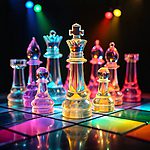
Why Chess Grandmasters Make Unstoppable Investors: The Second Level Thinking Definition in Action
May 23, 2025
Picture a chess grandmaster hunched over the board, eyes darting—not just at the next move, but at the moves behind the moves. Their genius isn’t in seeing what’s obvious; it’s in anticipating what their opponent thinks is obvious, then leaping a step further. Now, imagine this mentality in the investment world. The boldest investors aren’t satisfied with first-level answers; they’re obsessed with the “why behind the why.” Here’s the twist: while most market participants react to news, trends, or data at face value, the true outliers—those who thrive in chaos—are playing a different game entirely. Understanding the second level thinking definition isn’t just a mental quirk; it’s the secret engine behind every outsized return and every legendary market call. What does thinking one layer deeper mean, and how can this mindset transform chess and investing?
The Psychological Connection: Where Strategy Meets Market Mastery
Thinking Beyond the Obvious: Cognitive Complexity
Second level thinking is fundamentally about cognitive complexity—the ability to hold multiple possibilities, anticipate reactions, and question surface-level answers. In chess, this might mean sacrificing a piece to lure an opponent into a trap three moves ahead. In investing, it’s imagining not just how a company’s earnings report will impact the share price, but how the market will interpret that reaction, and how you should adjust accordingly.
Howard Marks, who popularised the term “second level thinking,” notes that most market participants are satisfied with simple logic: good news equals rising prices; bad news equals falling prices. But the second-level thinker asks: “Is this already priced in? What is the consensus missing?” Research in behavioural economics confirms that markets are often driven by “reflexive” responses—herd behaviour, recency bias, and overreaction. Second-level thinkers exploit these by anticipating not just events, but the psychology of the crowd.
Pattern Recognition and Adaptive Thinking
Both chess and investing reward those who see beneath the surface. Elite chess players have shown extraordinary pattern recognition, using it to predict and thwart even the most subtle strategies. Investors like Ray Dalio or George Soros apply similar pattern sensitivity, recognising economic signals or market cycles before consensus forms. This is more than logical deduction—it’s about developing adaptive mental models that evolve with new information.
A classic example: when US Federal Reserve policy shifts, first-level thinkers may simply react to interest rate changes. Second-level thinkers, by contrast, weigh how the market will overreact or underreact, positioning themselves not for the event, but for the market’s response to the event.
Emotional Discipline and Delayed Gratification
Second-level thinking also demands emotional regulation. The best chess players endure immense psychological pressure, resisting the urge for quick wins to set up long-term victories. In investing, the equivalent is staying calm during market panics, recognising when fear is overdone and opportunity is ripe. Behavioural science shows that emotional control—sometimes called “affect labelling”—directly correlates with the ability to make strategic, rather than impulsive, decisions.
Consider the 2020 stock market crash. Many fled in fear, but second-level thinkers asked: “If everyone is selling, who’s left to sell next? What happens after the panic?” Those who held their nerve reaped extraordinary rewards as the market rebounded.
Practical Applications: Building Your Second Level Thinking Muscle
1. Spot Your Own Surface-Level Patterns
Begin by catching yourself when you make snap judgments—whether in chess, markets, or everyday life. Are you reacting to the obvious, or pausing to question what others believe is obvious?
2. Apply Strategic Patience and Scenario Planning
Train yourself to play out multiple outcomes. Investing means not just forecasting company results, but imagining how various investor groups will interpret those results. Use scenario analysis: “If X, then Y; but if everyone expects Y, is Z more likely?”
3. Develop Transferable Mental Models
Borrow from chess: keep a “decision journal” tracking your predictions, reasoning, and outcomes. Over time, you’ll spot tendencies to fall into first-level traps—and develop resilience against them. In markets, practice entering positions only after mapping out how the crowd is likely to behave, not just what you believe will happen.
Case Study: The Contrarian Investor
During the late-2018 tech correction, most investors dumped high-growth US stocks, fearing further declines. A contrarian, second-level thinker noticed the panic was overdone, with fundamentals intact and sentiment overly negative. By buying when others fled, they captured the powerful rebound, demonstrating that the real edge lies not in being right but in being right when the crowd is wrong.
Key Takeaways
- Second level thinking requires questioning the obvious and anticipating the crowd’s response.
- Pattern recognition and scenario planning are essential skills in both investing and strategy games.
- Emotional discipline underpins every successful contrarian move.
- Document your decisions to reveal and correct first-level habits.
Questions for Reflection
- When did you last question the consensus—and what happened?
- How do you handle emotional swings in high-stakes situations?
- Where can you apply “second level thinking” outside of finance?
Conclusion: The Power of Thinking Deeper
The second level thinking definition isn’t just an investing buzzword—it’s the habit of mind that separates grandmasters from amateurs in every field. By learning to anticipate not just events, but the layered psychology of crowds, you unlock a strategic edge that transcends finance or chess. The next time you face a major decision, ask: What’s the next move behind the move? The answer may just redefine your path to mastery.










